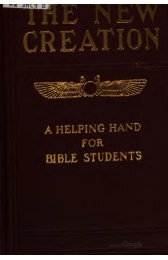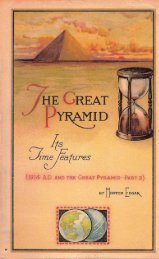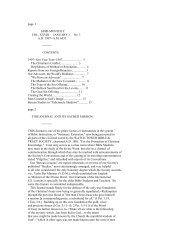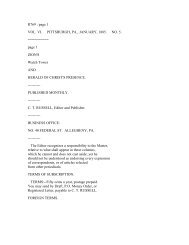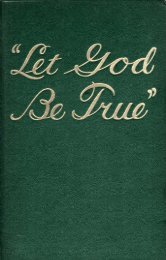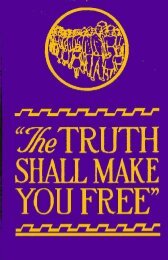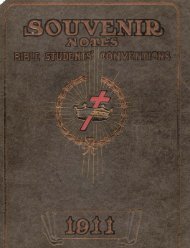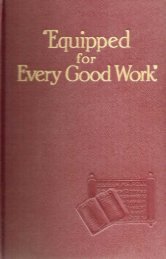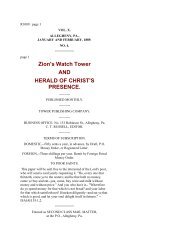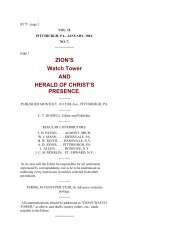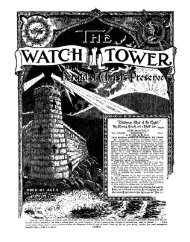The Watchtower Society and John and Morton Edgar - A2Z.org
The Watchtower Society and John and Morton Edgar - A2Z.org
The Watchtower Society and John and Morton Edgar - A2Z.org
- No tags were found...
You also want an ePaper? Increase the reach of your titles
YUMPU automatically turns print PDFs into web optimized ePapers that Google loves.
JUN~ 15, 1905 ZION'S WAT CH TOWER (183-184)great uprising." ''Hus condemned ita (Pspeq'e) worldliness,its right of ~eeuh poeseseions, <strong>and</strong> objected to the supremacyof the Pope. <strong>The</strong> Bible, amording to hi, ought tobe the Bole rule of faith."Professor Lodge in Close of the MiddEe Agcs, p. 207:-''<strong>The</strong>systematic teaching of Hue was for the moat part derived fromthe great English teacher, <strong>John</strong> Wycliffe. It is importantto remember that the Eusaite movement had a eecular ss wellas an ecclesiastical side."Burnett in Hiatory of the Refmtion, p. 9:-"Before theend of the 14th century, WyclWe bad extended hie line of attackto some of the s~eci doctrines of W&m theol-: but themovement whic~ he began, tho h ite &&e were-evaneecentin his own country, became inxe h<strong>and</strong>s of more st'md&hgadvocates s genuine national force in BohemianIII. THE 8EVE19 WEEK8 OF Dm. 7:PllIs there anything in the Gospel age to explain the myeteriousdivision of the 70 weeks into 7 <strong>and</strong> 62 <strong>and</strong> Itweeks is meant a period of 49 yan. As the aemn w ~ Gfrom Nehemiah's commission, the year under consideration willbe 1440 A. D. This is the time that Printing was invented, artnnt factor in the Reformation.ve%~~%hop Trench in Ye&d Oh-li Hidoty, p. 4e3:-''<strong>The</strong>n while abuses were never rifer, while the livee of theclergy were never fuller of ac<strong>and</strong>al, while the -1 Court wasnever more venal, nor could less endure the beating upon it ofthat fierce light which leaves nothing hid,-the invention ofprintin5 (1440) multiplied a thousendfold every voice whichwas ra~sed to proclaim an abuse or to denounce a corruptionAnd marching h<strong>and</strong> in h<strong>and</strong> with this wondrons invention therewas the revival of learning." -Ttr. 'FBE BETUBBY PBOM THE BABYLOWIAIP @3APTlVITY(6388. C.) AND TRE OONSEQWEWI! LAYIXQ OF THE FOUHIIA-TIONB OF TEE l'EBfPLB AT JEWBUSASEM<strong>The</strong> restoration was not begun, but waa mhed by Emin 487 B. C. In accordance with the Edict of Cyrus (536 B. C.)many of the Israelites returned from Babylon <strong>and</strong> laid thefoundations of the Temple. Ezra 4:24, however, at- thatthe work then "ceased unto the 2nd year of the reign of Darius,king of Persia" <strong>The</strong> length of time from the EMIct ofCyrus in 636 B. C. till the end of the 70 weeks in 36 AD. is572 years. Accordingly, the date in the &pel age which correspondswith 536 B. 0. is 1861 minus 572, equal to 1309 A. D.This year is of importance as marking the first year of what isuniversally known as the "Babylonian ca tivity" of the Papacyat Avignon, which is generally recognizJ an forming the foundationof the Reformation. It is curious that the year 536,which in the Jewish age concluded the Babylonian captivity ofthe Iaraelites, corresponds with the year 1309 in the Gospelage, which began the '(Babylonian captivity" of the Papacy.[May we not reverse the form of this statement <strong>and</strong> say thatit rather marked the first favorable condition for the liberationof the truth, which had long been in bondage to Papacy?-Editor.]Archbishop Trench in Yeobi& Chrch BL~toty, p. 276:-"<strong>The</strong>n in 1305 the French king contrived that the choice shouldfall on one who had so sold himself to carry out the wishes<strong>and</strong> policy of France that he did not feel anywhere eafe frompopular indignation except on the northern side of the Alps <strong>and</strong>under the protection of him whom he hml engaged to serve.After a brief residence at Bordeaux <strong>and</strong> then at Poitiera, Clement v. fixed his seat at Avignon. <strong>The</strong>re from 1309 to 1377he <strong>and</strong> six following Popes resided. <strong>The</strong> 'Babylonish Captivity'is the name by which this voluntary exile in a foreign l<strong>and</strong>with a eervile dependence on a foreign power, which this exileentailed, is often designated, the name having been suggestedby the 70 years or thereabouts for which this exile endured.<strong>The</strong> Popes could no longer be regarded as independent umpire8<strong>and</strong> arbiters. Nevertheless, they advanced claims to a universalmonarchy which stood in ridiculous contrast with theirown absolute dependence on the Court of France, s dependenceso abject that there were times when the Pope dared not giveaway the smallest preferment without permission Arst obtainedof the French king.',Professor Lodge in Close of the Yi&Ue Ages, p. 30:-"In1309 Clement v, fixed his residence at Avmon. As long asthe Popes continued to live there, they were exposed to overwhelmingFrench influence, <strong>and</strong> could hardly escape the chargemade both from Engl<strong>and</strong> <strong>and</strong> from Germany, that they weremere vassals of the King of France. It says much for th:vitality of the Papal System that the 'Babylonian captivity,as the next 70 years have been called, did not result in thecomplete loss not only of the Italian Provinces, but of allspiritual authority in Europe."Workman in D m of the Refmatiom, Vol. I., p. 16:-"<strong>The</strong> study of the Reformation ahould always begin with Avig-non. <strong>The</strong> greatnees of Luther <strong>and</strong> Calvin, as contrasted forinstance with Msrsiglio, WyeMe <strong>and</strong> Gerson, doee not lie eomuch in greater zeal, more thorough methode, more logical aim,as in their greater opportunity. <strong>The</strong> fulness of the time hadcome."V. Tgg BEBUILDmQ OF 5 TEMPLE IW TFlX SEOOXD TOTBE EIXTE YEAES OF DARIUSAs already mentioned, it was only the foundations of thetemple which were laid on the retnrn from Babylon. Buildingoperations were not roperly begun nntil the second year ofthe reign of Darius l!ystasps, king of Persia, <strong>and</strong> the templewas Anished in the sixth year of hie reign (Ezra 4 :24; 6: 15).Ussher'e chronologg gives the second year of Darius aa 620B. C., <strong>and</strong> the vamous authoritiea seem to corroborate this byplacing the date of his accession in the year 521. According tothis, the rebuilding of the temple began 16 yeare after the returnfrom Babylon. <strong>The</strong> corresponding date in the Gospel ageis 1385 (equals 1309 plus IS). <strong>The</strong> greatetrt work about thbtime was the publication of a book against the Papacy byMmiglio of Padue, but all the authorities which I consultedwere unanimous in stating that the year of publication of thisbook was 1324, not 1325 B. C. Accordingly, I was forced toconclude that there wae no time-parallel here, or, as seemedmore likely, that the eecond year of -nus waa 621, <strong>and</strong> not520 as allirmed. I epent several day8 in smhing all theworks on the history of Persia to which I had acceaa, <strong>and</strong> atlength my darts were rewarded. Professor Rawlinson, in hisFke &eat dZcnarch&s, VoI. 3, p. 404, states that Dar~ufimounted the throne on 1st January, 521 B. C., <strong>and</strong> be thenadds in a footnote on page 408, in connection with the statementaof Ezra 5:2 <strong>and</strong> Haggai 1:14, 15, that "accordin toJewish modes of reckoning" the 24th day of the 6th montf ofthe second year of Darius, would be September, 521 B. C., 8%months after Dariue' mession. <strong>The</strong>re can be no doubt thatthis is true explanation, as both Hapi <strong>and</strong> Ezra would reckonby the ecclesiastid year beginning in the Spring.<strong>The</strong> rebuilding of the bmple would, therefore, occupy thefour years from 621 to 517 B. C., <strong>and</strong> the corresponding yearsin the Gospel age would be 1324 to 1328 A. D It was in 1324that Marsiglio published his famous book, Defasw Pacis (Defenderof the Peace), <strong>and</strong> in 1328 he died. In the autumn ofthe same year the Emperor Lewis, who had been induced toattempt some of the reforms advocated by Marsiglio, deprivedof his (Marsiglio's) advice retired from Rime <strong>and</strong> relinquishedthe attempt.Archbishop Trench in hia Bidem2 Chwrch History, p. 280,in describing the story of the "Brrbylonish Captivity," says:-"As might easily be supposed, words bolder thnn had ever beenuttered before, words striking at the root of the Papal system,<strong>and</strong> leaving none of its prerogatives unassailed, had fo~~nd utterancesduring this time; <strong>and</strong> more ominous thnn all the rest,these had not come from such RS stood avowedly without thechurch's pale, but from those within. Foremost among thethreatening births of the first half of the 14th century is abook, the 'Defensor Pacis,' written by a physician of Padua,Marsiglio by name (died 1328), in the immediate service ofLewis of Bavaria No later h<strong>and</strong> has traced with a finer historicaltmt the mundane conditions which first made possible,<strong>and</strong> then favored, the upgrowth of the Papal power; none hassearched out with more unpitiable logic the weak places of thePapal armor. An epoch-making book, Ne<strong>and</strong>er calls it; <strong>and</strong>certain, for good or for eviL it was far in ndvanre of its ace:so far, that it ie difficult to underst<strong>and</strong> how it could verystrongly have influenced ite age."Workman in Dam of the Refowndotc, Vol. I, p. 80:-"InJune, 1324, with the help of his friend, <strong>John</strong> of J<strong>and</strong>un,-'thetwo pests,' as the Pope called them, 'from the abyss of Satan'-he wrote his great work in the incredible space of twomonths. Two years later, in the summer of 1.320, he joinedhimself to Lewis. He became the leader in a b<strong>and</strong> of visionarieswho urged the emperor on in his struggle with 'the gre~t.dragon <strong>and</strong> old serpent,' <strong>John</strong> xxii. In treatise after treatise,both Marsiglio <strong>and</strong> Ockham critieised the nature of the Papalpower, denied its claims <strong>and</strong> dem<strong>and</strong>ed the restoration ofswular supremncy." Page 85:-"<strong>The</strong> works of Marsiglio giveus in clar outline the ideals which now regulate the progressof Europe. <strong>The</strong> bolts which he f<strong>org</strong>ed have shattered the doctrineof divine right <strong>and</strong> the temporal claims of Papacy. Inhis emphasis of the value of Scripture, though the h<strong>and</strong> thatwrote was the h<strong>and</strong> of Marsiglio, the mice Reems the voire ofLuther: in his call to the laity he foreshadowed Wesley: inhis views as to the rights of separate congr-tions, he was aforerunner of the Independents."Professor Lodge in his work, <strong>The</strong> Close of the M W e Agee,p. 96, speaking about the ntrqgle between the Emperor Lewis<strong>and</strong> Pope <strong>John</strong> xxii., ssp:-"No previous eontest between theC357 71



